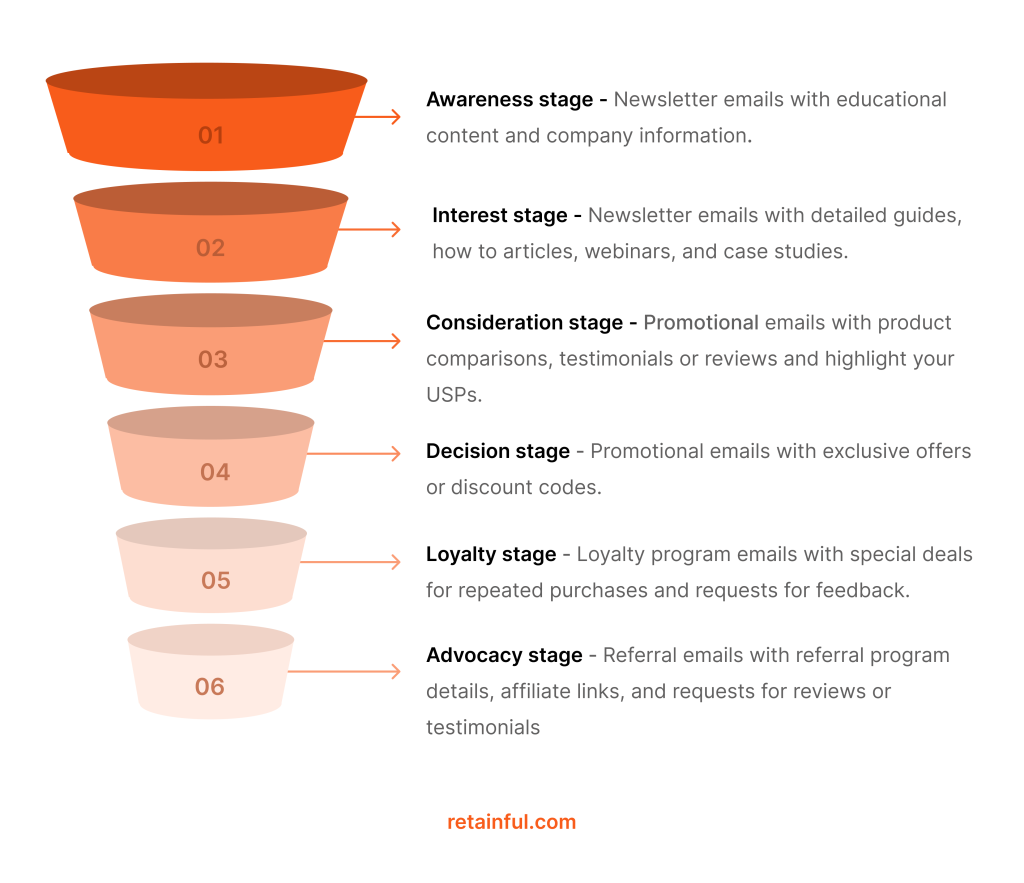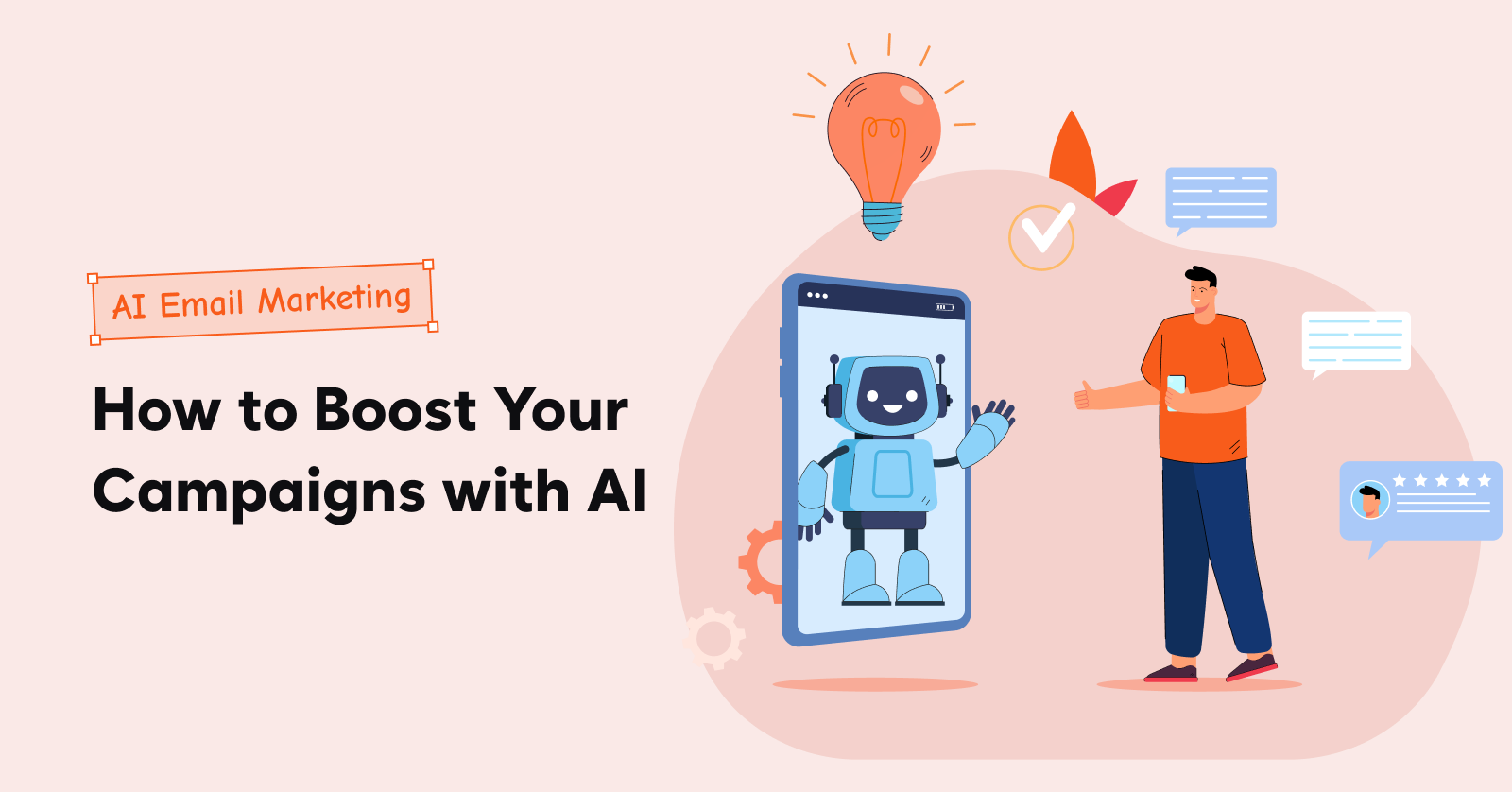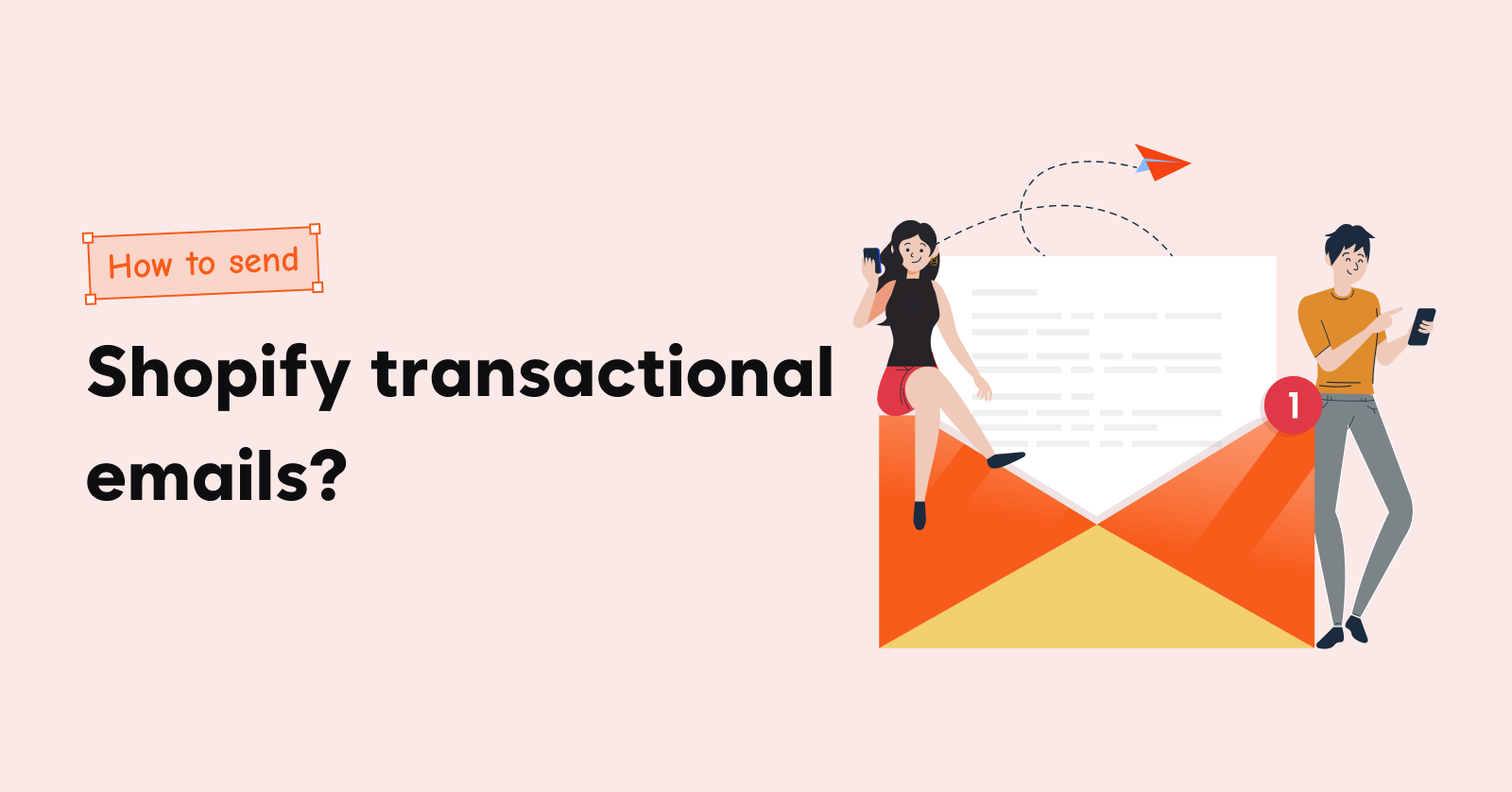Knowing email automation best practices will help you get the most out of your automated email campaigns.
Because there is more to email marketing automation than triggering email at a specific time. If done right, it allows you to target specific customers at the right time with the right message.
Email automation allows you to treat each subscriber as an individual, not a number in a mass mailing list. The benefits? Increased engagement and higher conversion rates – all while saving you time and resources.
In this blog, we’ll explore the nuances of email marketing automation best practices, learn about automated email workflows, and learn how to turn emails into targeted and personalized messages that resonate and drive action.
Launch all types of email campaigns effortlessly with Retainful’s easy-to-setup email automation.
How does Email Marketing Automation Work?
Email marketing automation is a technology that automates sending emails to your subscribers and customers. It works by setting up triggers based on specific customer actions or timings.
For example, when someone signs up for your newsletter, it can automatically send a welcome email. If customers abandon their shopping cart, an email can remind them to complete their purchase. You can also schedule regular updates or promotions.
Email automation leverages customer data and behavior to send emails at the right time, making them more likely to be opened.
Behind the hood, email automation consists of automated email workflows. Let’s learn what it is.
What are Automated Email Workflows?
An email automation workflow is a series of emails sent automatically based on specific criteria. These criteria, called triggers, can be subscriber actions (viewing products, purchases) or inactions (abandoned carts). The workflow then delivers a sequence of emails tailored to that specific trigger.
They are like pre-programmed journeys for your email subscribers. Think of them as a flowchart: subscribers enter at a starting point (e.g., sign-up) and follow a path based on their interactions.
For example, let’s say someone signs up for your email list. You can build a welcome email automation workflow that would work like this:
- Trigger: Subscriber signs up.
- First email: An automated welcome email is sent within minutes, thanking them for joining and introducing your brand.
- Second email: A few days later, a second email highlights popular products or content relevant to their interests.
- Third email: A third email might offer a discount code to incentivize their first purchase.
11 Email Automation Best Practices
- 1. Set a goal for each marketing automation workflow
- 2. Map the buyer journey
- 3. Segment email lists for tailored communication
- 4. Building automated email workflows for different buyer journeys
- 5. Use behavioral triggers
- 6. Prioritize lead scoring
- 7. Craft personalized and engaging email content
- 8. Timing your emails for optimal engagement
- 9. Choose an easy-to-set-up email automation app
- 10. Track performance
- 11. Do A/B Testing
The success of email automation is greatly influenced by how well it’s executed. This is where email marketing automation best practices come into play.
Adhering to these practices ensures that you can maximize the benefits of email automation while avoiding common pitfalls.
Let’s see these email marketing automation best practices in detail.
1. Set a goal for each marketing automation workflow
Marketing automation lets you build multiple automated email workflows. So, the first email automation best practice is to determine what you want each email automation workflow to achieve (welcome new subscribers, nurture leads, or promote sales).
In email marketing, having clear goals helps prioritize which workflows to build first based on your overall objectives. Is increasing sales more critical than lead nurturing at this stage? Goals provide a framework for decision-making.
2. Map the buyer’s journey
Don’t jump straight to sending. Mapping out subscriber journeys and identifying relevant triggers are the best email automation practice.
Mapping out the customer journey involves understanding your target audience’s path to becoming a customer – from the initial awareness of your brand to making a purchase and beyond, into the post-purchase and loyalty phases in the email marketing funnel.

This is an important email marketing automation best practice as it compliments other practices in the list too.
The subscriber needs, interests, and pain points you learn from mapping out the buyer’s journey serve as a goldmine of information for email personalization. You can segment your audience and craft emails that speak directly to their specific needs, increasing engagement and conversions.
3. Segment email lists for tailored communication
Email segmentation and automation go hand in hand. That’s why this email automation best practice holds an important place.
When these two email marketing strategies are used in tandem, they enable you to deliver highly personalized, relevant content to specific groups categorized based on their stage of buying journey, purchase history, demographics, or email engagement.
In this e-commerce email marketing best practice, once you map the customer journey and plan what emails to send, the next step is to use segmentation to group customers based on their stage so that your emails go only to those you target.
Other than the buying journey, you can segment your subscribers in various ways.
- Demographic segmentation: By time, location, gender/age, occupation/industry.
You send a special offer on professional development courses to subscribers who’ve indicated they are between the ages of 25 and 34, aiming to appeal to young professionals looking to advance their careers. - Purchase history segmentation: By purchase frequency, purchase value, product or category purchased or abandoned cart.
You send an email with product recommendations about accessories to customers who recently purchased a smartphone from your online store, personalizing suggestions based on the specific model they bought. - Engagement level segmentation: By open rate, click-through rate, content preferences, and conversion rate.
Subscribers who regularly open and click through your emails can receive exclusive content or early access to sales, rewarding and further engaging your most active subscribers.
Segment your customers based on various criteria using Retainful’s advanced segmentation and launch tailored campaigns.
4. Building automated email workflows for different buyer journeys
Building automated email workflows to align with the varied buyer journeys enhances the relevance and impact of your email marketing campaigns, guiding each segment of your audience through a personalized path to purchase.
The first step in executing this email automation best practice is to craft targeted email workflows for each stage of a buyer’s journey.
Develop a series of emails that cater to the buyer’s specific needs and guide them to the next stage.
- Awareness stage emails: Focus on providing valuable information and educational content that addresses the initial problem or need. This can include blog posts, guides, and tips relevant to their situation.
- Consideration stage emails: Share more detailed information about your solutions, including case studies, product comparisons, and customer testimonials. Highlight your value proposition and how you differentiate from competitors.
- Decision stage emails: Offer clear calls-to-action (CTAs), special promotions, or incentives to encourage the purchase in your automated email campaigns. Include strong reassurances like money-back guarantees or free trials to alleviate purchase anxieties.
5. Use behavioral triggers
Behavioral triggers allow you to launch these workflows at just the right time.
You can set up triggers based on user behavior, such as website activity, email interactions, or transaction history.
nnChoose triggers that align with your goals. For example, if your goal is to welcome new subscribers and introduce them to your brand, the trigger might be signing up for your email list. For win-back email campaigns, the trigger could be a period of inactivity.
6. Prioritize lead scoring
Lead scoring involves ranking leads based on their actions and engagement level with your brand. The score helps you gauge a lead’s interest and readiness to buy.
By following this email marketing campaign tip, leads can be automatically segmented into different categories based on their scores, triggering specific automated emails tailored to their level of engagement and interest.
7. Craft personalized and engaging email content
The efforts you put into building automated email workflows based on buyer journey and segmentation will go awry if you fail to personalize the emails unique to each customer segment.
In this email marketing best practice, too, customer data plays a huge role. You have to tailor the email content using the customer data you have used to segment the customer so that every customer segment receives email content that resonates with their unique preferences.
An example of a good email would be segmenting customers based on a specific product they have purchased and including a product recommendation that complements the purchase.
8. Timing your emails for optimal engagement
The idea is to send your automated emails at times when your subscribers are most likely to be checking their inboxes, thus increasing the chances of your emails being opened, read, and acted upon.
Along with other email automation best practices like behavioral triggers, timing the workflows to occur shortly after the action or at a specific time ensures the message is relevant and top of mind.
Timing isn’t just about when you send an email but also how often. Bombarding subscribers with too many emails, even at the right time, can lead to unsubscribes.
9. Choose an easy-to-set-up email automation app
With an email automation app, you can schedule email campaigns in advance or set up behavioral triggers based on user actions, such as signing up for a newsletter or making a purchase.
This email automation best practice ensures that the right messages reach the right people at the right time without any extra effort on your part.
Here is what to look for when choosing the right email marketing software:
- Automation features
The core of your choice should be robust automation functionalities.
This includes the ability to build automated email workflows and trigger-based emails that respond to subscriber actions.
These workflows can be simple, such as a welcome series for new subscribers, or more complex, involving multiple branches depending on how subscribers interact with each email. - Easy-to-setup
An easy-to setup email automation tool should offer a user-friendly interface for building automated email workflows, allowing you to define conditions, actions, and timing without requiring deep technical expertise. - Advanced segmentation capabilities
Choose a marketing automation app that allows for detailed segmentation based on various criteria, including demographics, behavior, purchase history, and engagement levels. This will enable more personalized and targeted campaigns.
10. Track performance
Monitor key metrics like open rates, click-through rates, and unsubscribe rates. Analyze data to refine your workflows.
In this email automation best practice, track key performance indicators (KPIs) relevant to your objectives.
For lead nurturing email campaigns, you might track engagement metrics such as open and click-through rates, while for conversion-focused campaigns, you’d monitor sales or conversion rates.
11. Do A/B Testing
In this email marketing automation best practice, don’t be afraid to experiment with different workflows, content, and sending times to see what works best for your audience.
Identify a single variable to test. This could be anything from the subject line, email content, call-to-action (CTA), send time, or email design.
Launch all types of email campaigns effortlessly with Retainful’s pre-designed automation workflows and easy-to-setup automation.
Wrapping up!!
From saving you precious time by handling routine tasks to personalizing experiences in ways that truly resonate with your audience, the benefits of email marketing automation are hard to ignore.
With the email marketing automation best practices we’ve discussed, you’re well on your way to not only reaching your audience more effectively but also creating experiences that they’ll appreciate and remember.
Learn more about platform-specific email marketing automation:
- Shopify Email Marketing: A Complete Guide to Create Successful Email Campaigns
- WooCommerce Email Marketing: An Ultimate Beginner’s Guide
- Shopify Marketing Automation: A Complete Guide (+Apps)
Frequently Asked Questions
Email flow refers to the journey an email takes from creation to the recipient’s inbox, focusing on the design and delivery process.
Email automation, however, involves pre-setting emails to send based on specific triggers or actions, emphasizing timeliness and relevance without manual intervention.
A good email sequence is characterized by relevance, personalization, and timing. It delivers valuable content tailored to the recipient’s interests and behaviors, gently guiding them through the sales funnel or customer journey with strategically placed calls to action.
To plan email automation, start by defining your goals and audience segments. Map out the customer journey, identifying key touchpoints for automated emails.
Choose triggers, design your emails, and set up the sequence in your email marketing platform. Finally, test and adjust based on performance.
Automation is the smartest choice for email marketing because it ensures timely, personalized communication with subscribers, increasing engagement and conversions.
It allows for efficient scaling of campaigns, improves customer experience, and offers valuable insights through data analysis, all while saving time and resources.
Yes, marketing automation can work for a small business by streamlining marketing tasks, improving efficiency, and allowing for targeted, personalized communication with prospects and customers.
It helps small businesses compete with larger entities by maximizing their marketing efforts and resources, even with limited staff or budget.
To succeed in marketing automation, focus on understanding your audience deeply to segment them accurately. Craft personalized, relevant content for each segment and use behavioral triggers to send timely communications.
Continuously test, analyze, and refine your strategies based on data insights to improve engagement and conversion rates over time.
An example of workflow automation is a lead nurturing campaign where a potential customer fills out a form on your website to download an eBook.
This action triggers a series of targeted follow-up emails providing additional information, encouraging further engagement, and gently guiding the lead toward making a purchase.



